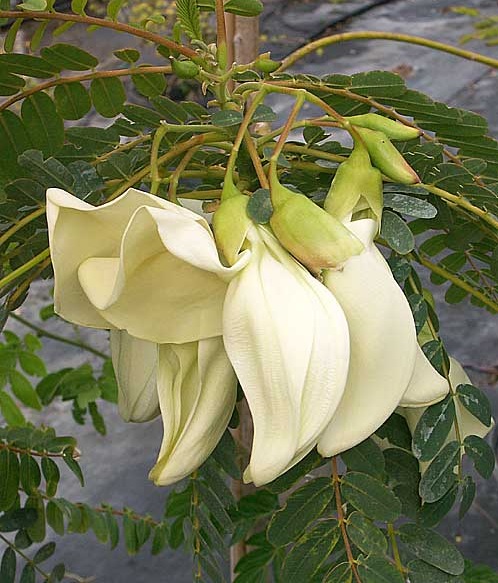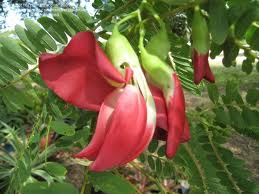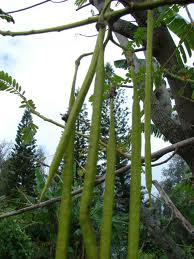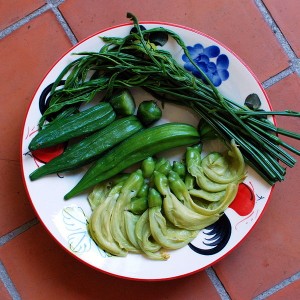Any plant called the Vegetable Hummingbird has to be written about.
Sesbania grandiflora, has managed to work its way into warmer areas of the world from its native India or southeast Asia. If you have a frost you might be able to pot it and take it inside but it won’t survive in the yard or field. It grows best in hot, humid areas including south Florida where it’s naturalized.
It has at least five dozen common names. Among them in English are: Sesbania, August Flower, Australian Corkwood Tree, Flamingo Bill, Grandiflora, Sesban, Swamp Pea, Tiger Tongue, Scarlet Wistaria, Vegetable Hummingbird, West Indian Pea, Parrot Flower, and White Dragon.
The shrub’s long narrow pods are eaten as a vegetable, similar in use to string beans. The seeds are fermented into a tempeh turi. Young leaves and shoots are eaten in salads or as a pot herb or in soups and stews. Its flowers are eaten raw in salads, boiled, fried or use in curries, stews and soups. They taste like mushrooms and are rich in iron and sugar, read sweet.
The Sesbania is a fast-growing tree with a typical adult height of between 3 and 15 feet. The leaves are regular and rounded and the flowers white and large, a cultivar is red blossomed. The tree thrives under full exposure to sunshine and is extremely frost sensitive. Pollinated by birds. A gum from tree wounds is called katurai and is red when fresh, nearly black after exposure. It’s an astringent gum, partially soluble in water and in alcohol, and is applied to fishing cord to make it more durable.
Sesbania (ses-BAN-nee-uh) is from the word Sesban which is derived from an Arab word for one of the species, S. sesban. Grandiflora (grand-dee-FLORL-uh) is much easier. It means large flowered. Other Sesbanias with edible parts include Sesbania coccinea, a cultivar of S. grandiflora, and the Sesbania sesban (the latter is also a forage crop for livestock.) The roasted seeds of the Sesbania canavillesii has been used as a coffee substitute. All other parts are toxic. Sesbania grandiflora‘s seeds are toxic to fish. An water extract of the bark is toxic to cockroaches.
Green Deane’s “Itemized” Plant Profile: Sesbania Grandiflora
IDENTIFICATION: Sesbania grandifolia: Tree to 40 feet, but usually smaller, thick, furrowed bark, and soft wood; leaves linate, six inches to a foot long, with 20 to 60 oblong leaflets one inch in length. Flowers pea-like, white, rose or maroon, 4″ long, fruit a pod half inch wide to two feet long.
TIME OF YEAR: Planted at beginning of your rainy season. Flowers and fruits second year though under good conditions can develop pods in nine months. Grows fast enough to be an annual fodder crop.
ENVIRONMENT: Full sun, no frost, fast growing, short lived, raised from seed. Salt tolerant. Easily damaged by wind. Very susceptible to nematodes,
METHOD OF PREPARATION: Young fruit, foliage and flowers edible, mature seeds not eaten, bark medicinal. Leaf protein amount ranges from 25 to 36%, flowers 14.5%.
Nutrition Analysis
Leaves contain per 100 g, 321 calories; 36.3 g protein; 7.5 g fat; 47.1 g carbohydrate; 9.2 g fiber; 9.2 g ash; 1684 mg Ca; 258 mg P; 21 mg Na; 2,005 mg K; 25,679 mg b-carotene equivalent; 1.00 mg thiamine; 1.04 mg riboflavin; 9.17 mg niacin and 242 mg ascorbic acid. The flowers contain per 100 g; 345 calories; 14.5 g protein; 3.6 g fat; 77.3 g carbohydrate; 10.9 g fiber; 4.5 g ash; 145 mg Ca; 290 mg P; 5.4 mg Fe; 291 mg Na; 1,400 mg K; 636 mg b-carotene equivalent; 0.91 mg thiamine; 0.72 mg riboflavin; 14.54 mg niacin; and 473 mg ascorbic acid.






Is it the same as the drumstick tree? The Philipinos plant them a lot in their yard in Hawaii!
Absolutely no. The drumstick tree is a totally different species, Moringa oleifera.
Molungay (Moringa) is also GREAT! I can see the confusion. The leaves have a similar look. We have a lot of plants with that look here. Quite a few of them have interesting uses.
I’ve been trying to find info on the Sesbania vesicaria. It’s a orange-red bloom and has smaller pods than the grandifolia. It has sprung up in the area after new water pipe was laid here in rural East Texas. Any ideas about being edible, etc. ??? Thanks
Jim Moore: Please don’t eat it!
Sesbania vesicaria, also called “bagpod sesbania,” is toxic. According to the Plants of Texas Rangelands Virtual Herbarium website: “Bag-pod sesbania contains sesbaimide, which is concentrated in the seed…Signs of (livestock) poisoning…after consumption can include: depression, diarrhea, Weakness, Rapid heart rate, Labored breathing, and Death.” For more information read: https://rangeplants.tamu.edu/plant/bag-pod-sesbania/
During my web search tonight I found numerous accounts of livestock poisonings and death due to grazing of Sesbania vesicaria on rangelands, and the most frequent accounts of human poisonings I found online are in plant identification website forums where frantic parents post pictures of the “mystery plant” their child just ate before violently vomiting and either presently in, or on their way to the emergency room.
The reason for my exhaustive web search regarding Sesbania vesicaria, is because one volunteered in my backyard earlier this year, grew to tree-like proportions, and is now in seed. It looked like a nitrogen-fixing legume to me, so I allowed the volunteer to grow all warm season, thinking I could later chop and drop the mature leaves, stems, etc. as green manure, and allow the hopefully nitrogen-fixing root nodules to remain in the soil to provide some residual nitrogen for fall crops. I could not positively identify the species until it went to seed.
Prior to “chopping and dropping” the leafy green and tender stem portions of the plant, I decided to remove and bag the green seed pods, as the rank smell of the plant and its rampant growth made me concerned both about potential plant toxins and potential invasive exotic status. (Hence the web search tonight).
My research tonight confirmed this plant’s toxicity, but the Florida Atlas of Vascular Plants still seems to list Sesbania vesicaria as “native” to Florida (http://florida.plantatlas.usf.edu/Plant.aspx?id=2379
Do you know of anyone selling plants or seeds in west central Florida (I’m in Sarasota). I checked ECHO’s website but they haven’t had a luck with this plant.
This plant has grown in m y backyard for years. Only grows to around 5 feet. Is delicate, white ball shaped flowers like a buttonwood bush. Has seed pods that are many seeded and small and tightly knit.
It has withstood 40 degrees below zero and survived. I live in Beloit Wi.
Oh that’s crazy! Ours here in the Philippines took ONE YEAR to grow more than three stories tall! Our fastest growing tree.
I found a Glottidium vesicarium that has pods with beans yet I can’t seem to dig up much information on it. Do you have any knowledge of this plant?